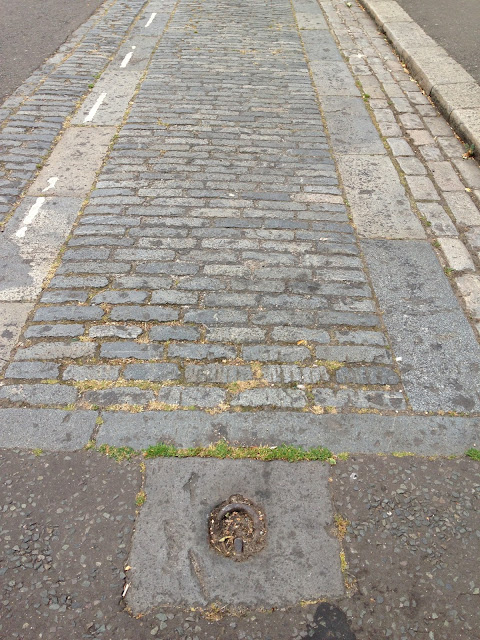Taxi!
Have you walked past this cobbled area in Somerfield Road and wondered why it's there?
 | |
| The cabstand in Somerfield Road |
In the 1860s development around Highbury, just south of the Brownswood fields, was principally aimed at a well-off class of resident, for whom the railway and omnibus network would not have been deemed socially appropriate, even if it had been more accessible. For 'gentlemen' the conveyance of choice would have been their own carriage. Consequently many of the large detached or semi-detached villas built at that time had their own coach house or stable, and would have had accommodation for a groom or driver.
When development spread north across the Brownswood Estate in the 1870s, the houses, though large, were designed for a different class of resident. Big enough for a large family and a domestic servant or two, they were designed to be homes for the families of the growing army of clerks and businessmen that mostly travelled to business in the City. The proximity to the newish Seven Sisters Station (late renamed Finsbury Park), providing quick access to the City, was a key feature of the development.
The Brownswood residents would not usually have been
expected to keep a carriage. It is unlikely that many could have afforded to.
The growing public transport network catered for their needs, and their
pockets. Nonetheless for all these families there would have been on occasion a
need for a carriage. And there would have been some individuals for whom public
transport was too slow, or too inconvenient, or simply insufficiently
classy. Edmund Yates’ (1831-94) wrote in 1879:
"THERE is a very large class of Riding London, which, while not sufficiently rich to keep its private carriage, holds omnibus conveyance in contempt and scorn, loathes flys, and pins its vehicular faith on cabs alone. "
"THERE is a very large class of Riding London, which, while not sufficiently rich to keep its private carriage, holds omnibus conveyance in contempt and scorn, loathes flys, and pins its vehicular faith on cabs alone. "
The Hackney Carriage was the answer - the original
horse-drawn cab, that gave its name to the London taxis of today. Here
in Somerfield Road is the local cab stand - the place where a cab would stand
awaiting hire, presumably associated with stables in Stable Place. It is paved
with granite setts, set crossways, to provide maximum traction for the horse's
hooves, while the wheel tracks are paved with large granite kerbs. Stone paving
was used partly because it stood up better to wear than the road surface,
but also because it was easier to to keep clean - a horse could be standing
there for a long time! A tethering ring is still there, set into the
roadway.
There were two kinds of cabs - the two-wheeled
Hansom and the four-wheeled Clarence or 'Growler'. The Hansom, described
as 'the gondolas of London' by Disraeli, was very speedy and maneuverable,
but could take only two passengers.
For more than two people a Growler
was needed.
Charles Dickens describes a scene that might have been
seen in Somerfield Road:
There is a hackney-coach stand under the very window at
which we are writing; there is only one coach on it now, but it is a fair
specimen of the class of vehicles to which we have alluded - a great,
lumbering, square concern of a dingy yellow colour (like a bilious brunette),
with very small glasses, but very large frames; the panels are ornamented with
a faded coat of arms, in shape something like a dissected bat, the axletree is
red, and the majority of the wheels are green. The box is partially covered by
an old great-coat, with a multiplicity of capes, and some extraordinary-looking
clothes; and the straw, with which the canvas cushion is stuffed, is sticking
up in several places, as if in rivalry of the hay, which is peeping through the
chinks in the boot. The horses, with drooping heads, and each with a mane and
tail as scanty and straggling as those of a worn-out rocking-horse, are
standing patiently on some damp straw, occasionally wincing, and rattling the
harness; and now and then, one of them lifts his mouth to the ear of his
companion, as if he were saying, in a whisper, that he should like to
assassinate the coachman. The coachman himself is in the watering-house; and
the waterman, with his hands forced into his pockets as far as they can
possibly go, is dancing the 'double shuffle,' in front of the pump, to keep his
feet warm.
If you'd like to know more about the Hackney carriage in
London have a look at Cab
Cultures in Victorian London


Comments
Post a Comment